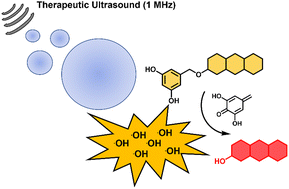Fluorescence-based chemical tools for monitoring ultrasound-induced hydroxyl radical production in aqueous solution and in cells†
Abstract
We report the synthesis of hydroxyl-radical (˙OH) responsive fluorescent probes that utilise the 3,5-dihydroxybenzyl (DHB) functionality. 4-Methylumbeliferone-DHB (Umb-DHB) and resorufin-DHB (Res-DHB) in the presence of ˙OH radicals resulted in significant increases in their respective fluorescent emission intensities at 460 nm and 585 nm. The incubation of Res-DHB in HeLa cells followed by therapeutic ultrasound (1 MHz) resulted in a significant increase in fluorescence emission intensity thus permitting the ability to monitor ultrasound-induced ˙OH production in live cells.



 Please wait while we load your content...
Please wait while we load your content...